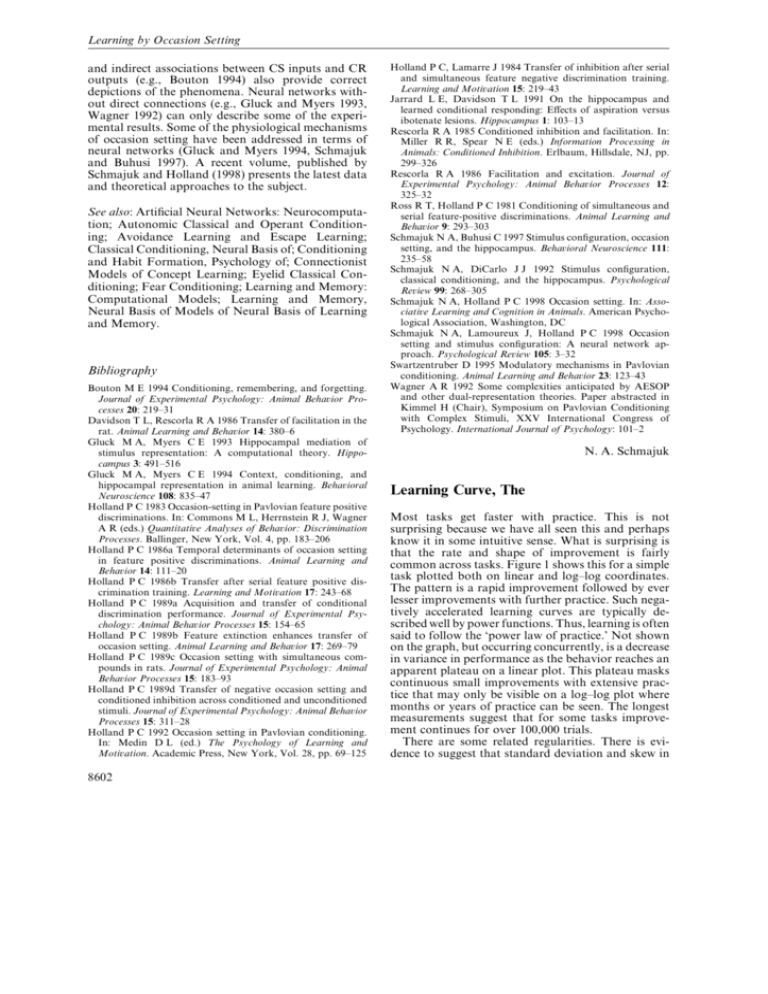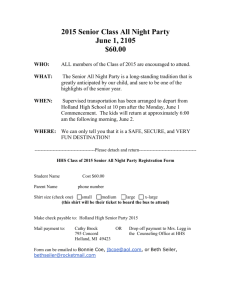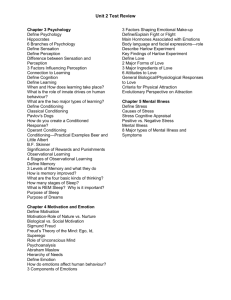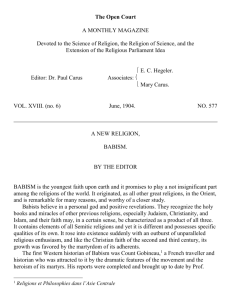
Learning by Occasion Setting
and indirect associations between CS inputs and CR
outputs (e.g., Bouton 1994) also provide correct
depictions of the phenomena. Neural networks without direct connections (e.g., Gluck and Myers 1993,
Wagner 1992) can only describe some of the experimental results. Some of the physiological mechanisms
of occasion setting have been addressed in terms of
neural networks (Gluck and Myers 1994, Schmajuk
and Buhusi 1997). A recent volume, published by
Schmajuk and Holland (1998) presents the latest data
and theoretical approaches to the subject.
See also: Artificial Neural Networks: Neurocomputation; Autonomic Classical and Operant Conditioning; Avoidance Learning and Escape Learning;
Classical Conditioning, Neural Basis of; Conditioning
and Habit Formation, Psychology of; Connectionist
Models of Concept Learning; Eyelid Classical Conditioning; Fear Conditioning; Learning and Memory:
Computational Models; Learning and Memory,
Neural Basis of Models of Neural Basis of Learning
and Memory.
Bibliography
Bouton M E 1994 Conditioning, remembering, and forgetting.
Journal of Experimental Psychology: Animal Behaior Processes 20: 219–31
Davidson T L, Rescorla R A 1986 Transfer of facilitation in the
rat. Animal Learning and Behaior 14: 380–6
Gluck M A, Myers C E 1993 Hippocampal mediation of
stimulus representation: A computational theory. Hippocampus 3: 491–516
Gluck M A, Myers C E 1994 Context, conditioning, and
hippocampal representation in animal learning. Behaioral
Neuroscience 108: 835–47
Holland P C 1983 Occasion-setting in Pavlovian feature positive
discriminations. In: Commons M L, Herrnstein R J, Wagner
A R (eds.) Quantitatie Analyses of Behaior: Discrimination
Processes. Ballinger, New York, Vol. 4, pp. 183–206
Holland P C 1986a Temporal determinants of occasion setting
in feature positive discriminations. Animal Learning and
Behaior 14: 111–20
Holland P C 1986b Transfer after serial feature positive discrimination training. Learning and Motiation 17: 243–68
Holland P C 1989a Acquisition and transfer of conditional
discrimination performance. Journal of Experimental Psychology: Animal Behaior Processes 15: 154–65
Holland P C 1989b Feature extinction enhances transfer of
occasion setting. Animal Learning and Behaior 17: 269–79
Holland P C 1989c Occasion setting with simultaneous compounds in rats. Journal of Experimental Psychology: Animal
Behaior Processes 15: 183–93
Holland P C 1989d Transfer of negative occasion setting and
conditioned inhibition across conditioned and unconditioned
stimuli. Journal of Experimental Psychology: Animal Behaior
Processes 15: 311–28
Holland P C 1992 Occasion setting in Pavlovian conditioning.
In: Medin D L (ed.) The Psychology of Learning and
Motiation. Academic Press, New York, Vol. 28, pp. 69–125
8602
Holland P C, Lamarre J 1984 Transfer of inhibition after serial
and simultaneous feature negative discrimination training.
Learning and Motiation 15: 219–43
Jarrard L E, Davidson T L 1991 On the hippocampus and
learned conditional responding: Effects of aspiration versus
ibotenate lesions. Hippocampus 1: 103–13
Rescorla R A 1985 Conditioned inhibition and facilitation. In:
Miller R R, Spear N E (eds.) Information Processing in
Animals: Conditioned Inhibition. Erlbaum, Hillsdale, NJ, pp.
299–326
Rescorla R A 1986 Facilitation and excitation. Journal of
Experimental Psychology: Animal Behaior Processes 12:
325–32
Ross R T, Holland P C 1981 Conditioning of simultaneous and
serial feature-positive discriminations. Animal Learning and
Behaior 9: 293–303
Schmajuk N A, Buhusi C 1997 Stimulus configuration, occasion
setting, and the hippocampus. Behaioral Neuroscience 111:
235–58
Schmajuk N A, DiCarlo J J 1992 Stimulus configuration,
classical conditioning, and the hippocampus. Psychological
Reiew 99: 268–305
Schmajuk N A, Holland P C 1998 Occasion setting. In: Associatie Learning and Cognition in Animals. American Psychological Association, Washington, DC
Schmajuk N A, Lamoureux J, Holland P C 1998 Occasion
setting and stimulus configuration: A neural network approach. Psychological Reiew 105: 3–32
Swartzentruber D 1995 Modulatory mechanisms in Pavlovian
conditioning. Animal Learning and Behaior 23: 123–43
Wagner A R 1992 Some complexities anticipated by AESOP
and other dual-representation theories. Paper abstracted in
Kimmel H (Chair), Symposium on Pavlovian Conditioning
with Complex Stimuli, XXV International Congress of
Psychology. International Journal of Psychology: 101–2
N. A. Schmajuk
Learning Curve, The
Most tasks get faster with practice. This is not
surprising because we have all seen this and perhaps
know it in some intuitive sense. What is surprising is
that the rate and shape of improvement is fairly
common across tasks. Figure 1 shows this for a simple
task plotted both on linear and log–log coordinates.
The pattern is a rapid improvement followed by ever
lesser improvements with further practice. Such negatively accelerated learning curves are typically described well by power functions. Thus, learning is often
said to follow the ‘power law of practice.’ Not shown
on the graph, but occurring concurrently, is a decrease
in variance in performance as the behavior reaches an
apparent plateau on a linear plot. This plateau masks
continuous small improvements with extensive practice that may only be visible on a log–log plot where
months or years of practice can be seen. The longest
measurements suggest that for some tasks improvement continues for over 100,000 trials.
There are some related regularities. There is evidence to suggest that standard deviation and skew in
Learning Cure, The
Figure 1
Time to perform a simple task on a linear and log–log
plot as well as a power law fit to the data (adapted
from Seibel 1963)
performance time also decrease according to a power
law, but with worse correlations. Indeed, in some cases
the decrease in standard deviations appears to cause
the improvement, because the minimum time to
perform a task does not change (Rabbitt and Banerji
1989).
The power law of practice is ubiquitous. From short
perceptual tasks to team-based longer term tasks of
building ships, the breadth and length of human
behavior, the rate that people improve with practice
appears to follow a similar pattern. It has been seen in
pressing buttons, reading inverted text, rolling cigars,
generating geometry proofs, and manufacturing machine tools (cited in Newell and Rosenbloom 1981),
performing mental arithmetic on both large and small
tasks (Delaney et al. 1998), performing a scheduling
task (Nerb et al. 1999), and writing books (Ohlsson
1992). Further examples are noted in reviews (e.g.,
Heathcote et al. 2000). In manufacturing this curve
is called a progress function. It can be demonstrated
by taking a task—nearly any task—and timing how
long it takes to complete over 10 trials, or better over
a hundred trials. An example might be to try reading
this article upside down. The time per paragraph will
generally decrease, but with some differences caused
by the different words and paragraph lengths.
In general, the more averaging, the smoother the
curve. The learning curve appears smoother when the
data is averaged across subjects, across tasks, or both.
When the tasks are known to vary in difficulty, such as
different complex mental arithmetic problems (e.g.,
27i5 and 23i28), the learning curve only appears
when averaging is performed because the different
problems naturally take different times. Even when
problems are of comparable difficulty, subjects may
use different strategies. For example, arithmetic
problems can be solved by two at least strategies,
retrieval and calculation. The power law applies across
strategies, but the fit is better to each strategy (Delaney
et al. 1998), or even an individual’s strategies (Heathcote et al. 2000).
Averaging can mask important aspects of learning.
If the tasks vary in difficulty, the resulting line will not
appear as a smooth curve, but will bounce around.
Careful analysis can show that different amounts of
transfer and learning are occurring on each task. For
example, solving the problem 22i43 will be helped
more by previously solving 22i44 than by solving
17i38 because there are more multiplications shared
between them. Where subtasks are related but
different, such as sending and receiving Morse code,
the curves can be related but visibly different (Bryan
and Harter 1897).
The learning curve has implications for learning in
education and everyday life. It suggests that practice
always helps improve performance, but that the most
dramatic improvements happen first. Another implication is that with sufficient practice people can
achieve comparable levels of performance. For
example, extensive practice on mental arithmetic
(Staszewski reported in Delaney et al. 1998) and on
digit memorization have turned average individuals
into world class performers.
To sum up, the learning curve is visible with enough
aggregation of dissimilar tasks or across similar tasks
down to the level of individual subject’s strategies.
1. Mathematical Definitions
The shape of the curve is negatively accelerated—
further practice improves performance, but with
diminishing returns. Power laws and exponentials are
both functions that provide this shape. Mathematical
definitions are given in Table 1. The exact quality of
the fit depends on innumerable details of averaging,
the precise function used, and the scale. For example,
the full power law formula is the most precise, but it
has additional terms that are difficult to compute, and
8603
Learning Cure, The
Table 1
Functions that fit practice data
Time l MinTimejB:(NjE)−β [Full power law
formula]
Time l B:N−β [Simple power law formula]
Time l B:e−αN [Simple exponential formula]
B is the range of learning
N is the trial number
E is the number of previous practice trials
α,β are the learning rate parameters
the asymptote is usually only visible when there are
over 1,000 practice trials (Newell and Rosenbloom
1981). The typical power law formula is simpler, but
leaves out previous practice. When using this formula,
the coefficients of the power law for a set of data can be
easily computed by taking the log of the trial number
and log of task time and computing a linear regression.
That is, fitting a regression in log–log space.
In general, the power function fit appears to be
robust, regardless of the methods used (Newell and
Rosenbloom 1981). However, recent work (Heathcote
et al. 2000) suggests that the power law might be an
artifact arising from averaging (Anderson and Tweney
1997), and that the exponential function may be the
best fit when individual subjects employing a single
strategy are considered. Distinguishing between the
power and exponential functions is not just an esoteric
exercise in equation fitting. If learning follows an
exponential, then learning is based on a fixed percentage of what remains to be learnt. If learning
follows a power law, then learning slows down in that
it is based on an ever decreasing percentage of what
remains to be learnt.
Regardless of the functional form of the practice
curve, there remain some systematic deviations that
cause problems, at the beginning and end of long
series. The beginning deviations may represent an
encoding process. For example, it may be necessary to
transform a declarative description of a task into
procedures before actual practice at the task can begin
(Anderson and Lebiere 1998); the residuals at the end
may represent approaching the minimum time for a
given task as defined by an external apparatus. These
effects appear in Fig. 1 as well.
2. Process-based Explanations of the Learning
Cure
The power law of learning is an important regularity
of human behavior that all theories of learning must
address. For example, Logan (1988) suggests that the
retrieval of memory traces guides responding in
speeded tasks. Response times represent the fastest
retrieval time among the memory traces racing to
8604
Figure 2
The time to perform a trouble-shooting task by both a
cognitive model and a subject (after Ritter and Bibby
2001)
guide the response. The power law falls out of this
analysis, because with practice the number of redundant memory traces increases, which, in turn,
increases the chances of observing fast retrieval times.
Olhsson’s (1996) theory notes how the learning curve
could arise out of error correction. Different assumptions (e.g., how fast errors are caught) give rise to
different curves including the exponential and power
law. The learning curve has also been demonstrated
for connectionist models as well.
ACT-R (Anderson and Lebiere 1998) and SOAR
(Newell 1990), two cognitive architectures, generally
predict a power law speedup, but for different reasons.
ACT-R does this because rules and memory traces are
strengthened according to a power law based on the
assumption that the cognitive system is adapted to the
statistical structure of the environment (Anderson and
Schooler 1991). Several models in SOAR (see Cognitie Theory: SOAR) have been created that model the
power law (e.g., Nerb et al. 1999, Newell 1990). These
models explain the power law as arising out of
mechanisms such as hierarchical learning (i.e., learning
parts of the environment or internal goal structure)
that initially learns low-level actions that are very
common and thus useful, and with further practice
more useful larger patterns that occur infrequently are
learned. The SOAR models typically vary from human
learning in that they learn faster than humans, and
they do not learn for as long a period. SOAR and
ACT-R also predict variance in the improvement on
all tasks due to different amounts of transfer across
problems and learning episodes. Figure 2 shows how
such a model can predict differential transfer as well as
continuous learning as it appears in human data.
3. Summary
The learning curve is a success story for cognitive
psychology, which has shown that learning is ubiquitous and has provided mathematical accounts of the
Learning from Text
rate. The learning curve is also a success story for
cognitive modeling, which has explained many aspects
of the curve and the noise inherent in it partly as
differences in transfer of knowledge between tasks and
how the curve arises out of mechanisms necessary for
processing. The multiple explanations also suggest
that there may be multiple ways that the curve can
arise.
See also: Categorization and Similarity Models; Cognitive Theory: ACT; Cognitive Theory: SOAR; Mathematical Learning Theory; Mathematical Learning
Theory, History of; Memory Models: Quantitative;
Transfer of Learning, Cognitive Psychology of
Bibliography
Anderson J R, Lebiere C 1998 The Atomic Components of
Thought. Erlbaum, Mahwah, NJ
Anderson J R, Schooler L J 1991 Reflections of the environment
in memory. Psychological Science 2: 396–408
Anderson R B, Tweney R D 1997 Artifactual power curves in
forgetting. Memory and Cognition 25: 724–30
Bryan W L, Harter N 1897 Studies in the physiology and
psychology of the telegraphic language. Psychological Reiew
4: 27–53
Delaney P F, Reder L M, Staszewski J J, Ritter F E 1998 The
strategy specific nature of improvement: The power law
applies by strategy within task. Psychological Science 9(1): 1–7
Heathcote A, Brown S, Mewhort D J K 2000 The power law
repealed: The case for an exponential law of practice.
Psychonomic Bulletin and Reiew 7: 185–207
Jones G, Ritter F E, Wood D J 2000 Using a cognitive
architecture to examine what develops. Psychological Science
11(2): 1–8
Logan G D 1988 Toward an instance theory of automatization.
Psychological Reiew 95: 492–527
Nerb J, Ritter F E, Krems J 1999 Knowledge level learning and
the power law: A Soar model of skill acquisition in scheduling.
In: Wallach D, Simon H A (eds.) Kognitionswissenschaft
[Journal of the German Cognitie Science Society] Special issue
on cognitive modeling and cognitive architectures, pp. 20–9
Newell A 1990 Unified Theories of Cognition. Harvard University
Press, Cambridge, MA
Newell A, Rosenbloom P S 1981 Mechanisms of skill acquisition
and the law of practice. In: Anderson J R (ed.) Cognitie Skills
and their Acquisition. Erlbaum, Hillsdale, NJ, pp. 1–51
Ohlsson S 1992 The learning curve for writing books: Evidence
from Asimov. Psychological Science 3(6): 380–2
Ohlsson S 1996 Learning from performance errors. Psychological Reiew 103(2): 241–62
Rabbitt P, Banerji N 1989 How does very prolonged practice
improve decision speed? Journal of Experimental Psychology:
General 118: 338–45
Ritter F E, Bibby P A 2001 Modeling how and when learning
happens in a simple fault-finding task. Proceedings of the 4th
International Conference on Cognitie Modeling. Erlbaum,
Mahwah, NJ
Rosenbloom P S, Newell A 1987 Learning by chunking, a
production system model of practice. In: Klahr D, Langley P,
Neches R (eds.) Production System Models of Learning and
Deelopment. MIT Press, Cambridge, MA, pp. 221–86
Seibel R 1963 Discrimination reaction time for a 1,023alternative task. Journal of Experimental Psychology 66(3):
215–26
F. E. Ritter and L. J. Schooler
Learning from Text
In many everyday situations we need to acquire
information from texts, both oral and written, such as
newspaper articles, manuals, talks, or telephone conversations. Learning from text is a ubiquitous occurrence. Of course, the exceptional interest that the
topic has received is driven by the need to improve
learning from text in formal educational settings.
Research on this issue has been motivated by different,
but related, goals. Educational research is mostly
concerned with the development and evaluation of
teaching methods (Hynd et al. 1998), linguistic theory
is concerned with the description and analysis of the
texts used as learning materials, and the psychological
literature focuses more on the cognitive processes
subserving comprehension and learning (e.g., Kintsch
1998). In the late twentieth century, the advancement
of text comprehension theories has made it possible to
apply concepts from psycholinguistic research to
educational issues, so that there is now more and more
overlap between these areas.
1. Definitions
How do we define learning from text? Learning from
text is often equated with learning of text, that is, with
memory for the text information proper (e.g., the
memorization of a poem). In contrast, Kintsch makes
a clear distinction and defines learning from text as ‘the
ability to use the information acquired from the text
productively in novel environments’ (Kintsch 1998,
p. 290).
Using concepts from psycholinguistic theories of
text comprehension, these definitions can be further
sharpened: van Dijk and Kintsch (1983) distinguish
three levels of representation. First, the surface level
encodes the verbatim wording of the text information.
On this level, the syntactic and lexical realization of
the text is represented. The second level is a semantic
representation, called the textbase, closely corresponding to the propositional, or meaning-based content,
but independent of the exact wording. In addition, the
textbase contains some information not explicitly
mentioned in the text, such as associative elaborations,
certain inferences, and macropropositions. Finally,
and most importantly, the situation model is an
integration of the reader’s prior knowledge and
experiences with the information currently encountered. This representation of ‘what the text is all about’
8605
Copyright # 2001 Elsevier Science Ltd. All rights reserved.
International Encyclopedia of the Social & Behavioral Sciences
ISBN: 0-08-043076-7







